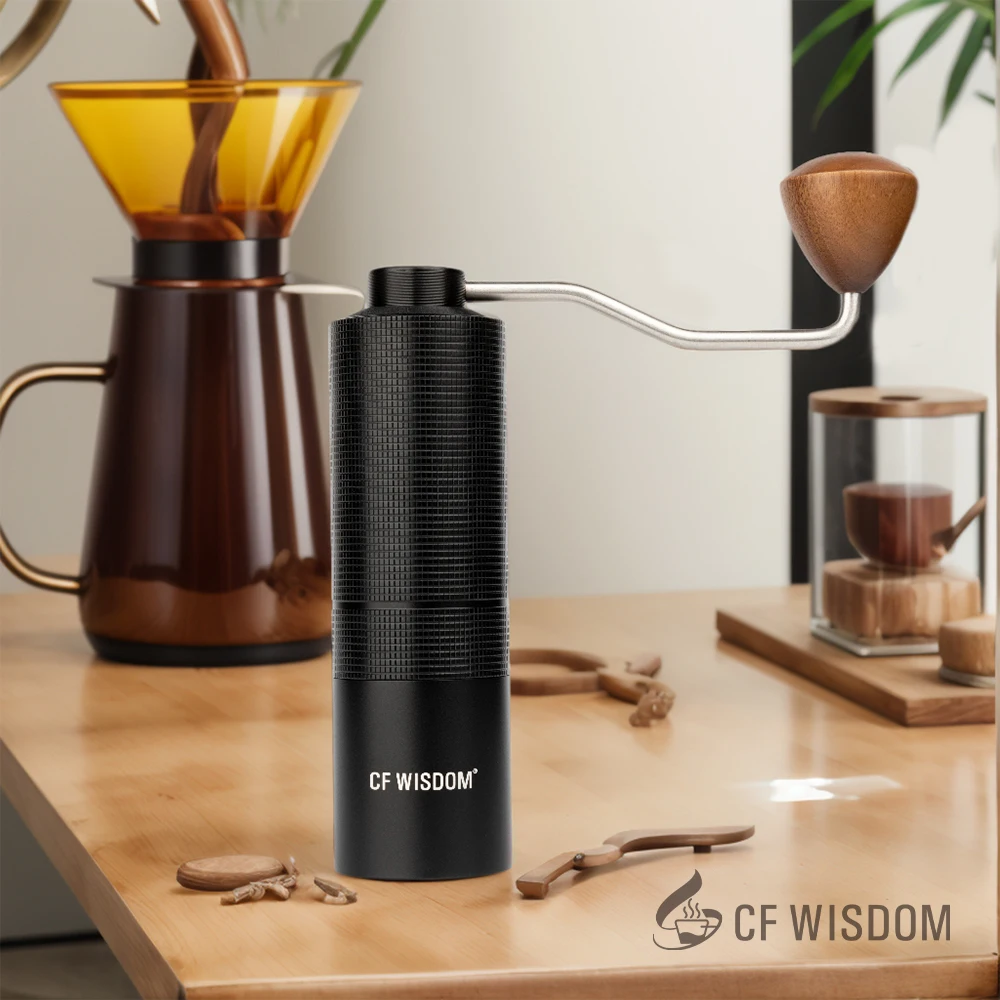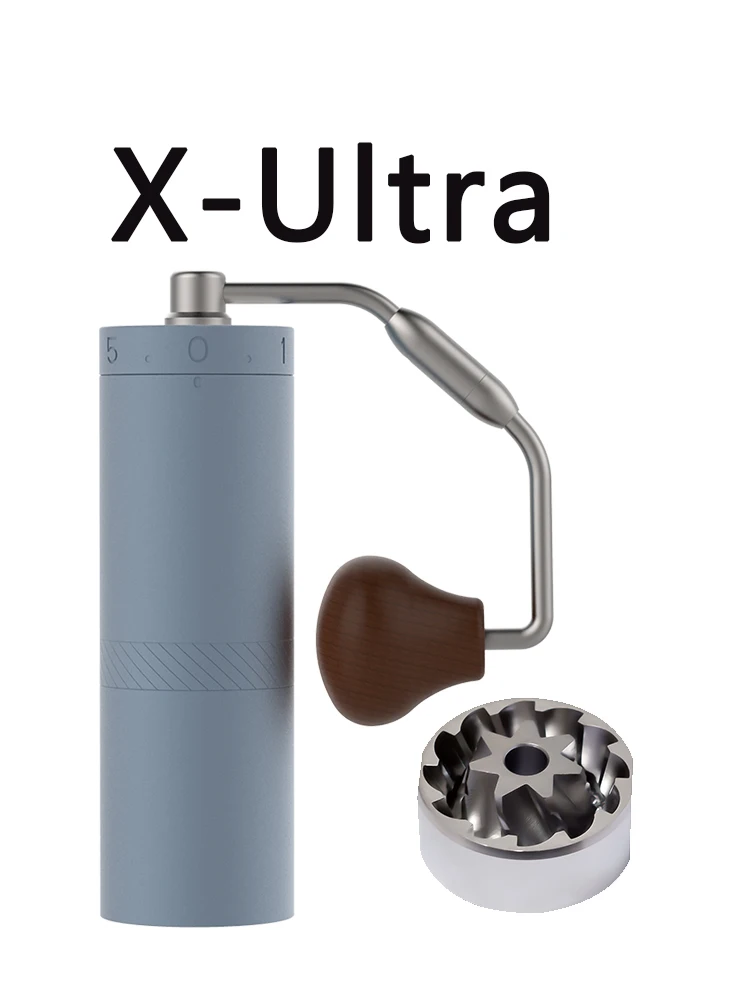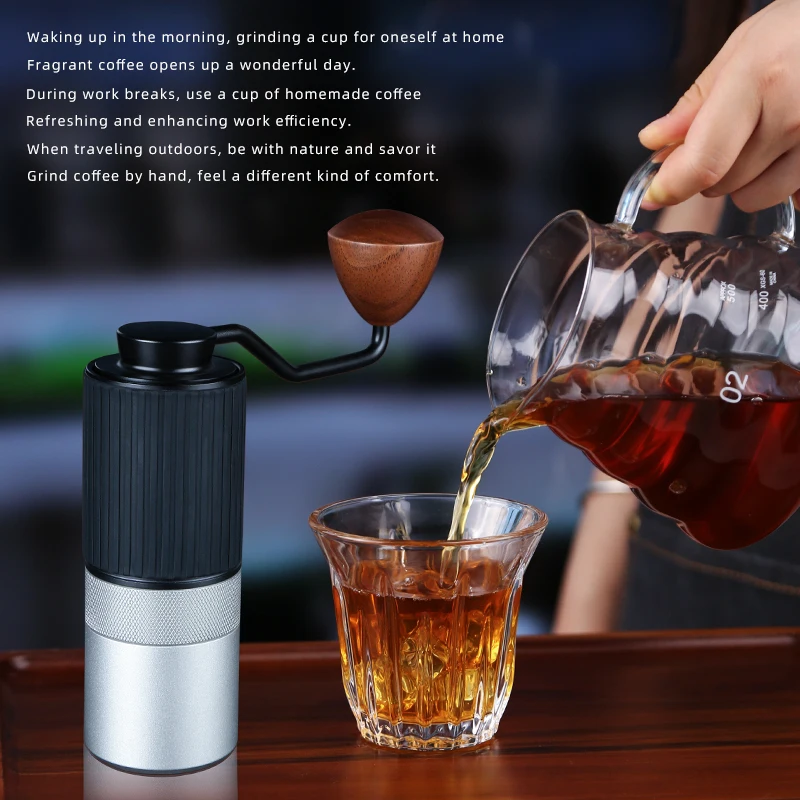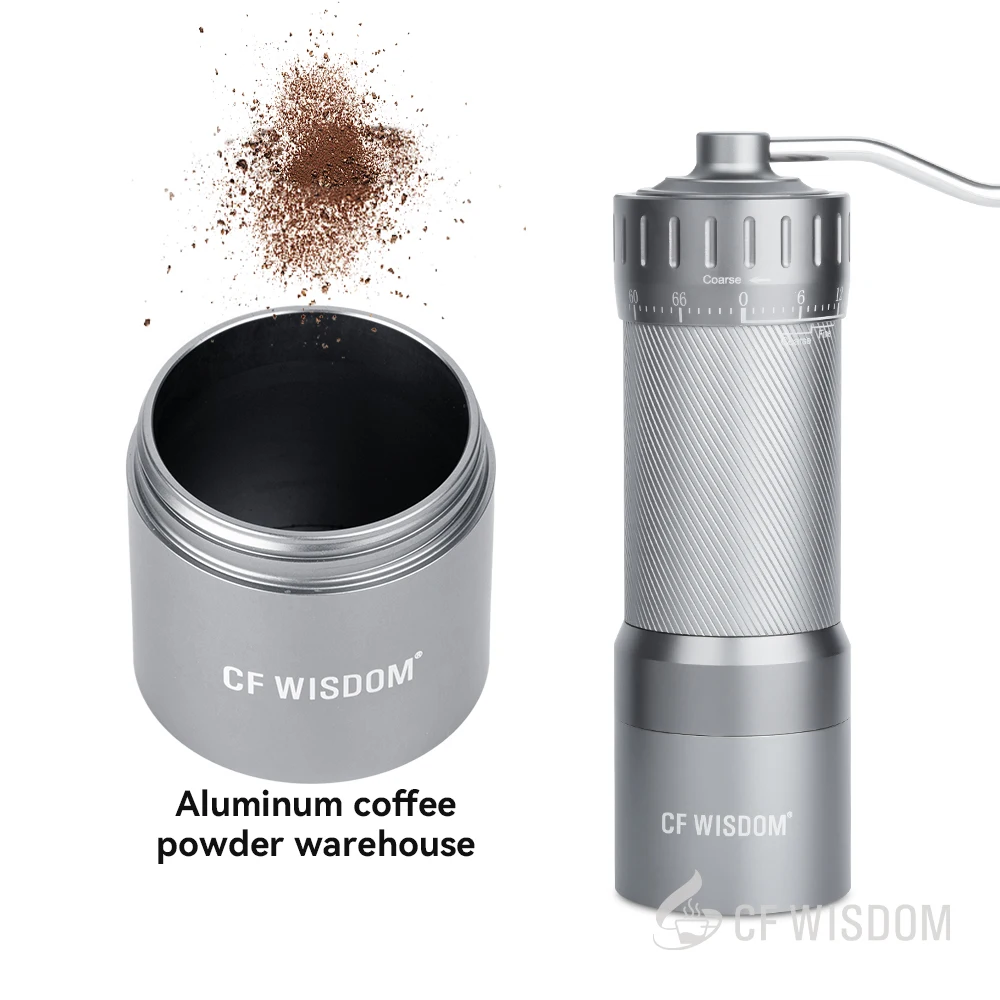Understanding Steel Burrs in Commercial Coffee Environments
Steel burrs represent the heart of professional coffee grinding operations, serving as precision-engineered grinding surfaces specifically designed to create consistent coffee particle sizes. These hardened steel components work in pairs, with one stationary and one rotating, to systematically crush coffee beans to the desired fineness for extraction.
In commercial coffee environments, steel burrs play a fundamental role in maintaining flavor consistency across hundreds of drinks daily. Their ability to produce uniform grounds directly affects extraction quality, ensuring customers receive the same exceptional flavor profile with every cup. Unlike home grinders, commercial equipment must handle high-throughput operations without compromising grind quality or overheating.
The difference between burr and blade grinders becomes particularly important in professional settings. While blade grinders simply chop beans randomly, creating inconsistent particle sizes, ceramic vs steel burr coffee grinders use precision engineering to crush beans between textured surfaces with carefully calibrated gaps. This precision is why specialty cafés, restaurants, and high-volume coffee shops overwhelmingly choose burr grinders with steel components.
Steel burrs have become the industry standard in professional settings due to their exceptional durability and precision. Their ability to maintain consistent grinding performance even when processing hundreds of pounds of coffee daily makes them ideal for busy commercial environments where reliability is non-negotiable. The ceramic vs steel burr comparison reveals important distinctions that influence which material works best in different operational contexts.
Key Advantages of Steel Burrs for High-Volume Coffee Production
Superior Speed and Efficiency
- Process significantly larger volumes of coffee in less time (typically 3-7 pounds per minute)
- Maintain consistent operation during peak service periods without overheating
- Reduce customer wait times during rush periods without sacrificing quality
Unparalleled Sharpness and Precision
Steel burrs excel at maintaining the precise particle size distribution crucial for proper extraction. This consistency directly translates to reliable flavor profiles cup after cup, even when grinding continuously throughout busy service periods.
Enhanced Durability Under Pressure
The structural integrity of steel burrs makes them particularly well-suited for commercial operations. They’re designed to withstand thousands of pounds of coffee before requiring replacement, making them economically advantageous for high-volume establishments. The ceramic-steel burr longevity guide explores how different materials perform under continuous use.
Effective Heat Management
While steel does conduct heat, commercial-grade grinders incorporate cooling systems to manage temperature during operation. This heat management capability prevents flavor degradation even during extended grinding sessions typical in busy cafés.
Precision For Multiple Brewing Methods
Steel burrs provide the tight tolerances necessary for espresso preparation while also offering the versatility to handle coarser grinds for batch brew, pour-over, and other preparation methods. This adaptability makes them invaluable in operations serving diverse coffee offerings.
Our manual coffee burr grinders collection features commercial-quality options that demonstrate these advantages on a smaller scale, perfect for appreciating the engineering that goes into professional equipment.
Performance Metrics: Steel Burrs Under Commercial Pressure
Commercial steel burrs demonstrate their true value when subjected to the relentless demands of busy coffee operations. The performance metrics reveal why they remain the standard for professional environments despite alternatives entering the market.
Grind Consistency Metrics
Particle size distribution is perhaps the most critical performance indicator for commercial burrs. Professional-grade steel burrs typically deliver:
- Minimal deviation in particle size (usually within 100-200 microns)
- Controlled fines production (particles under 100 microns)
- Even distribution across the desired grind range
- Consistency maintained throughout grinding sessions
This consistency directly impacts extraction, with properly maintained steel burrs enabling extraction yields between 18-22% for espresso and 19-21% for filter coffee—the ranges most professionals target for optimal flavor.
Seasoning and Break-in Period
New steel burrs require a “seasoning” period before reaching optimal performance. During this initial phase:
- Microscopic burr edges become polished through use
- Fines production gradually decreases as edges smooth
- Flavor clarity improves as consistency stabilizes
- Full seasoning typically requires grinding 10-20kg (22-44lbs) of coffee
Commercial operations often dedicate specific coffee for this break-in period, recognizing that performance improves significantly once burrs are properly seasoned.

Throughput Capacity
Steel burrs in commercial settings demonstrate remarkable capacity:
* Typical 64mm burrs: 5-7 grams per second (18-25kg/hr)
* Larger 83mm burrs: 7-10 grams per second (25-36kg/hr)
* Can handle continuous operation during 2-3 hour rush periods
* Maintain consistent particle distribution even at maximum throughput
Brewing Method Optimization
Steel burrs perform differently depending on brewing application:
For Espresso:
* Exceptional particle uniformity prevents channeling during extraction
* Precise adjustment capabilities allow for minor corrections to flow rate
* Minimal clumping compared to ceramic alternatives
For Filter Coffee:
* Controlled fines production for clean, clear cup profiles
* Consistent medium-coarse particles for even extraction
* Reduced “boulders” (oversized particles) that lead to under-extraction
Understanding heat retention between steel vs ceramic helps baristas optimize their workflow to maintain consistency throughout service periods.
Lifespan and Durability: Maximizing Steel Burr Longevity
Steel burrs demonstrate remarkable longevity in commercial settings, though their ultimate lifespan depends on multiple factors. Understanding these variables helps coffee operations maximize their investment and maintain optimal performance.
Typical Lifespan Metrics
Standard commercial steel burrs typically process:
* 500-1,000kg (1,100-2,200lbs) of coffee before replacement is recommended
* Approximately 16,000-33,000 espresso shots (at 18g per shot)
* 6-18 months of service in a busy café environment
Premium burrs with specialized coatings can extend these figures significantly, often processing 2-3 times more coffee before showing similar wear.
Factors Affecting Wear Rate
Several variables accelerate or extend burr lifespan:
- Bean Hardness: Denser beans (typically light roasts) cause faster wear
- Roast Level: Darker, more brittle beans cause less wear than light roasts
- Foreign Objects: Stones or other contaminants cause immediate damage
- Cleaning Frequency: Regular cleaning prevents oil buildup that accelerates wear
- Grinder Design: Quality of alignment and motor affects wear patterns
- Daily Volume: More coffee equals faster wear, though not always linearly
Recognizing Wear Indicators
Coffee professionals should monitor for these signs that burr replacement is needed:
- Increasing grind time for the same volume of beans
- Higher operating temperatures during grinding
- Changing noise signature (often becoming louder)
- Visible flattening of cutting edges under magnification
- Inconsistent extraction despite maintaining grind settings
- Need for increasingly finer settings to achieve the same flow rate
The ceramic vs steel grinder burrs comparison helps professionals understand how different materials show wear patterns over time.
Economic Considerations
Timely replacement of worn burrs offers significant economic advantages:
* Prevents progressive quality degradation that customers might notice
* Maintains grinding efficiency, reducing electricity costs and time
* Avoids sudden failure during peak service periods
* Typically costs 10-25 cents per pound of coffee ground over the burr lifetime
Our stainless steel manual coffee grinders collection demonstrates how quality steel components contribute to grinder longevity even in smaller-scale applications.
Advanced Materials: Steel Burr Composition and Coatings
The material science behind commercial coffee burrs has advanced significantly, with manufacturers developing specialized alloys and coatings to enhance performance and durability.
Steel Types and Properties
| Steel Type | Hardness (HRC) | Corrosion Resistance | Best For |
|---|---|---|---|
| Tool Steel | 60-62 | Moderate | Standard commercial use |
| High-Carbon | 62-64 | Lower | High-volume specialty coffee |
| Stainless | 58-60 | Excellent | Environments with humidity concerns |
| Hardened Tool Steel | 64-66 | Moderate | Premium commercial applications |
Manufacturing Methods
Two primary manufacturing approaches yield distinctly different performance characteristics:
Cast Burrs:
* Formed by pouring molten metal into molds
* Lower production costs
* More affordable replacement parts
* Require longer seasoning periods (15-20kg of coffee)
* Generally good for medium-volume operations
Cut (Machined) Burrs:
* Precision-milled from solid steel blanks
* Higher manufacturing costs
* More precise cutting geometry
* Shorter seasoning period (5-10kg of coffee)
* Superior performance in high-end commercial settings

Specialized Coatings
Advanced coatings have revolutionized burr longevity and performance:
- Titanium Nitride (TiN): Gold-colored coating increasing hardness to 80+ HRC, extending life 3-5x
- Diamond-Like Carbon (DLC): Black coating with exceptional hardness, extending life 5-10x
- Red Speed: Red-colored coating with superior wear resistance and reduced friction
- Tungsten Carbide: Extremely durable coating extending life up to 6x
- Boron Carbide Nitride (BCN): One of the hardest materials, approaching diamond in durability
The cost premium for coated burrs typically ranges from 50-200% over standard steel, but the lifespan extension often delivers superior return on investment for high-volume operations. Understanding the relationship between coffee grinder burr size and these advanced materials helps operators optimize their equipment choices.
Steel vs. Ceramic: Material Comparison for High-Volume Use
When evaluating materials for commercial coffee grinding, understanding the distinct advantages of both steel and ceramic helps operators make informed decisions.
Durability Comparison
Steel Advantages:
* Higher tensile strength and impact resistance
* Less likely to chip or shatter when foreign objects enter the grinder
* Better resistance to mechanical stresses in high-volume environments
Ceramic Advantages:
* Superior wear resistance for pure coffee grinding
* Maintains edge sharpness longer than uncoated steel
* Potential for longer service intervals between replacements
Performance Under Continuous Use
Steel Performance:
* Maintains structural integrity during all-day grinding sessions
* Can handle constant stop-start operations without damage
* Withstands vibration and mechanical stresses without fracturing
Ceramic Performance:
* Excellent for steady, continuous grinding
* More vulnerable to mechanical shock during peak periods
* Requires more careful bean screening to prevent damage
Heat Management Differences
Steel Heat Characteristics:
* Higher thermal conductivity draws heat away from beans
* Can transfer more heat to beans during extended operation
* Often requires cooling systems in high-volume environments
Ceramic Heat Characteristics:
* Lower thermal conductivity minimizes heat transfer to coffee
* Maintains more stable temperature during grinding
* Better preservation of volatile compounds in heat-sensitive coffees
Foreign Object Resistance
Steel burrs significantly outperform ceramic when dealing with small stones or other contaminants that occasionally appear in even the best coffee supplies. While steel might dull slightly upon contact with a stone, ceramic burrs often chip or crack completely, necessitating immediate replacement.
Our flat burr hand grinder collection demonstrates how these material differences manifest in precision grinding equipment.
Essential Maintenance for Commercial Steel Burrs
Proper maintenance of steel burrs ensures consistent performance, extended lifespan, and optimal coffee quality. Establishing regular cleaning protocols is essential for busy commercial operations.
Daily Quick-Clean Protocol
Perform these steps at closing time daily:
1. Run grinder empty to clear retention chambers
2. Remove hopper and vacuum loose grounds from entrance chute
3. Use a grinder brush to clean accessible surfaces
4. Wipe external surfaces with a clean, dry cloth
5. Document any changes in performance or grinding time
Deep Cleaning Process (Weekly)
For busier operations grinding 5+ pounds daily:
1. Disconnect power source completely
2. Remove and empty bean hopper
3. Follow manufacturer instructions to safely remove the burrs
4. Use a dedicated grinder brush to clean all coffee residue from burrs
5. Use compressed air (if available) to blow out compacted grounds
6. Clean the grinding chamber and chutes with a brush
7. Reassemble carefully, ensuring proper alignment
8. Run 20-30g of coffee through and discard (removes any loose debris)
Specialized Cleaning Products
- Grinder cleaning tablets: Specially formulated to absorb oils without damaging burrs
- Food-safe brushes: Softer than wire but firm enough to remove coffee residue
- Wooden toothpicks: Ideal for cleaning tight spaces without scratching metal
- Microfiber cloths: For wiping external surfaces without leaving fibers behind
Never use water directly on steel burrs, as this can promote rust formation. Similarly, avoid harsh chemicals that might compromise food safety or damage coatings.
Calibration Maintenance
Monitoring and maintaining proper calibration ensures consistent grinding:
1. Mark original calibration points for reference
2. Check alignment weekly using calibration tools
3. Document any drift or adjustments needed
4. Verify grind consistency with visual inspection and extraction timing
Understanding how burr heat affects coffee grounds helps maintenance staff recognize when cleaning is necessary to prevent heat-related quality issues.
Our precision manual grinder collection demonstrates the importance of proper burr maintenance in achieving consistent results.
Troubleshooting Common Steel Burr Issues
Even well-maintained commercial grinders occasionally develop issues that require diagnosis and correction. Addressing these problems promptly maintains coffee quality and prevents equipment damage.
Inconsistent Grind Size
Problem Signs:
* Visibly uneven particles in ground coffee
* Inconsistent extraction times between shots
* Uneven bed formation in filter brewing
Potential Solutions:
1. Check burr alignment and adjust if necessary
2. Inspect for wear patterns or damaged cutting edges
3. Verify burr carrier for wobble or play
4. Clean thoroughly to remove compacted grounds
Excessive Heat Generation
Normal vs. Abnormal:
* Normal: Warm to touch after continuous use
* Abnormal: Hot to touch, burning smell, or visibly darkened grounds
Solutions:
1. Implement cooling periods between grinding sessions
2. Check for binding or resistance in the burr mechanism
3. Verify appropriate amperage draw against specifications
4. Consider aftermarket cooling modifications if consistently overheating

Static and Clumping Issues
Physics Behind the Problem:
Static electricity builds up as beans fragment and particles rub against metal surfaces, causing grounds to stick together and to grinder components.
Practical Solutions:
1. Implement RDT (Ross Droplet Technique) – very slightly moistening beans
2. Use anti-static grind cups or containers
3. Ground the grinder properly (check electrical connections)
4. Allow grounds to rest briefly before handling
Fine Adjustment Hand Grinder, Precision Manual Grinder, Travel Coffee Grinder
Price range: $185.11 through $494.63 Select options This product has multiple variants. The options may be chosen on the product pageHand Burr Grinder, Hand Crank Coffee Grinder, Manual Espresso Grinder, Portable Coffee Grinder
Price range: $262.72 through $300.22 Select options This product has multiple variants. The options may be chosen on the product pageManual Burr Mill, Manual Coffee Grinder Stainless Steel, Manual Coffee Mill Grinder, Mechanical Coffee Grinder
Price range: $127.26 through $130.32 Select options This product has multiple variants. The options may be chosen on the product pageHand Burr Grinder, Manual Coffee Grinder Stainless Steel, Precision Manual Grinder
Price range: $183.64 through $187.52 Select options This product has multiple variants. The options may be chosen on the product page
Grinder Stalling or Choking
Diagnostic Process:
1. Determine if the issue is mechanical or electrical
2. Check for obstructions in the grinding chamber
3. Verify beans aren’t too oily or dark (causing buildup)
4. Inspect motor capacitor if stalling occurs consistently
Solutions:
1. Clean thoroughly, paying special attention to the discharge chute
2. Consider using a coarser initial grind setting
3. Implement a purge between grind setting changes
4. Check motor ventilation and cooling
Unusual Noises
Common Sounds and Causes:
* Clicking: Foreign object or burr contact
* Scraping: Burrs set too close or misaligned
* Laboring hum: Motor strain or bearing issues
* Rattling: Loose components or mounting
Always investigate unusual sounds immediately, as they often indicate problems that can quickly escalate to more serious damage.
Selecting the Right Steel Burr Grinder for Commercial Use
Choosing the ideal grinder for a commercial coffee operation requires balancing several key factors to match specific business needs and coffee programs.
Burr Size Considerations
Larger burrs generally offer advantages for high-volume operations:
| Burr Diameter | Typical Grind Speed | Best For |
|---|---|---|
| 58-60mm | 1.5-2.5g/sec | Small cafés, secondary brewing methods |
| 64-65mm | 3-5g/sec | Medium-volume cafés, standard option |
| 75-83mm | 5-8g/sec | High-volume specialty cafés |
| 98-120mm | 8-15g/sec | Very high throughput operations |
Larger burrs not only grind faster but generate less heat per gram of coffee, preserving more volatile compounds.
Motor Specifications
Commercial grinders require motors designed for continuous duty cycles:
* Look for motors rated for commercial/continuous use (not intermittent)
* Minimum 500W for medium volume, 750W+ for high volume operations
* Direct drive systems typically offer better longevity than belt-driven
* Thermal protection features prevent motor burnout during peak periods
Dosing Mechanism Options
Different dosing systems suit different operational styles:
- Timed Dosing: Simplest, measures by time rather than weight
- Volumetric Dosing: Uses volume to approximate dose, moderate consistency
- Gravimetric (Weight-Based): Highest precision, measures actual coffee weight
- On-Demand Grinding: Minimizes oxidation, grinds directly into portafilter
For high-volume espresso service, grinders that combine speed with precise dosing typically optimize both workflow and quality.
Our manual espresso grinder collection showcases precision engineering principles similar to commercial equipment.
Grind Retention Challenges
Retention (coffee remaining inside the grinder) affects both waste and freshness:
* Most commercial grinders retain 5-15g of coffee in the grinding chamber
* Low-retention designs incorporate vertical burrs or sweeper systems
* Purging 2-3g between setting changes minimizes cross-contamination
* Some designs include programmable purge cycles for efficiency
Cooling Systems
Heat management becomes crucial at commercial volumes:
* Active Cooling: Fans or other mechanisms to dissipate heat
* Passive Cooling: Heat sink designs and thermal-dissipating materials
* Motor Cooling: Separate ventilation for motor heat vs. grinding chamber
* Burr Cooling: Direct cooling for the burrs themselves in premium models
Investing in effective cooling systems pays dividends in flavor quality, especially for light roast specialty coffee programs that are more vulnerable to heat degradation.
Our all-metal hand grinder collection demonstrates durable construction principles important in commercial environments.
Supplemental: Future Trends in Commercial Burr Technology
The coffee grinding landscape continues to evolve with innovations addressing longstanding challenges and improving performance metrics.
Advanced Coating Technologies
Next-generation coatings are pushing durability boundaries:
* Nano-ceramic composite surfaces combining metal toughness with ceramic wear resistance
* Multi-layer coatings that address both friction and durability
* Biocompatible coatings eliminating concerns about metal transfer to coffee
These advancements promise to extend burr life beyond current limitations while maintaining flavor integrity.
Digital Integration and Monitoring
Smart technology is entering the grinding sphere:
* Embedded sensors monitoring burr temperature during operation
* Wear detection systems alerting to degrading performance before quality suffers
* Grinding pattern analysis suggesting optimal replacement timing
* Integration with shop management systems to track maintenance needs
Sustainability Innovations
Eco-conscious design improvements focus on:
* Recyclable burr materials designed for easy separation and processing
* Refurbishable burr systems allowing reconditioning rather than replacement
* Energy-efficient grinding mechanisms reducing power consumption
* Extended lifespan designs minimizing waste generation
Hybrid Materials
Manufacturers are exploring combined material advantages:
* Steel cores with ceramic edges combining structural strength with wear resistance
* Carbon-infused steel offering improved hardness without brittleness
* Composite structures optimizing different properties for different parts of the burr
These hybrid approaches aim to deliver the best qualities of multiple materials without their respective disadvantages.
Critical Questions About Steel Burrs in Commercial Settings
Can steel burrs handle oily, dark roasts in high-volume settings?
Yes, steel burrs can effectively handle oily, dark roasts in commercial environments, though they require more frequent cleaning. The natural oils in dark roasts tend to build up on burr surfaces, potentially affecting grind consistency and flavor if not addressed. Implementing a daily cleaning protocol prevents oil accumulation from compromising performance or causing clumping issues, making steel burrs perfectly suitable for establishments specializing in darker roast profiles.
What exactly happens when steel burrs overheat during continuous use?
When steel burrs overheat during continuous operation, several negative consequences occur. First, excessive heat transfers directly to the coffee particles, volatilizing aromatic compounds prematurely and flattening the flavor profile. Second, thermal expansion can slightly alter the calibrated gap between burrs, shifting the grind size during operation. Third, oils in the coffee can begin to cook onto the burr surfaces, creating buildup that affects cutting efficiency. Finally, extreme overheating can potentially affect the hardness of the steel or damage special coatings, permanently reducing burr performance.
How do different grinder RPM settings affect steel burr performance and longevity?
Grinder RPM significantly impacts both performance and burr lifespan. Lower RPM settings (700-900 RPM) typically generate less heat and produce fewer fines, while potentially extending burr life by reducing friction and impact forces. Higher RPM settings (1200-1400 RPM) increase throughput but generate more heat and potentially more fines, which can accelerate wear. The optimal RPM depends on the specific burr design, with larger burrs generally performing better at lower RPM due to their greater surface area and higher cutting efficiency.
Which preventative maintenance steps are most critical for steel burrs?
The most critical preventative maintenance steps for steel burrs include: regular cleaning to prevent oil buildup and rancidity, proper calibration checks to ensure consistent particle size, inspection for foreign object damage after any unusual sounds, and maintaining proper alignment between burrs. Of these, thorough cleaning is arguably the most important as it prevents the cascade of problems that oil buildup causes: increased friction, higher operating temperatures, motor strain, and flavor degradation. Establishing a documented cleaning schedule based on volume (rather than time) ensures consistent performance regardless of business fluctuations.







